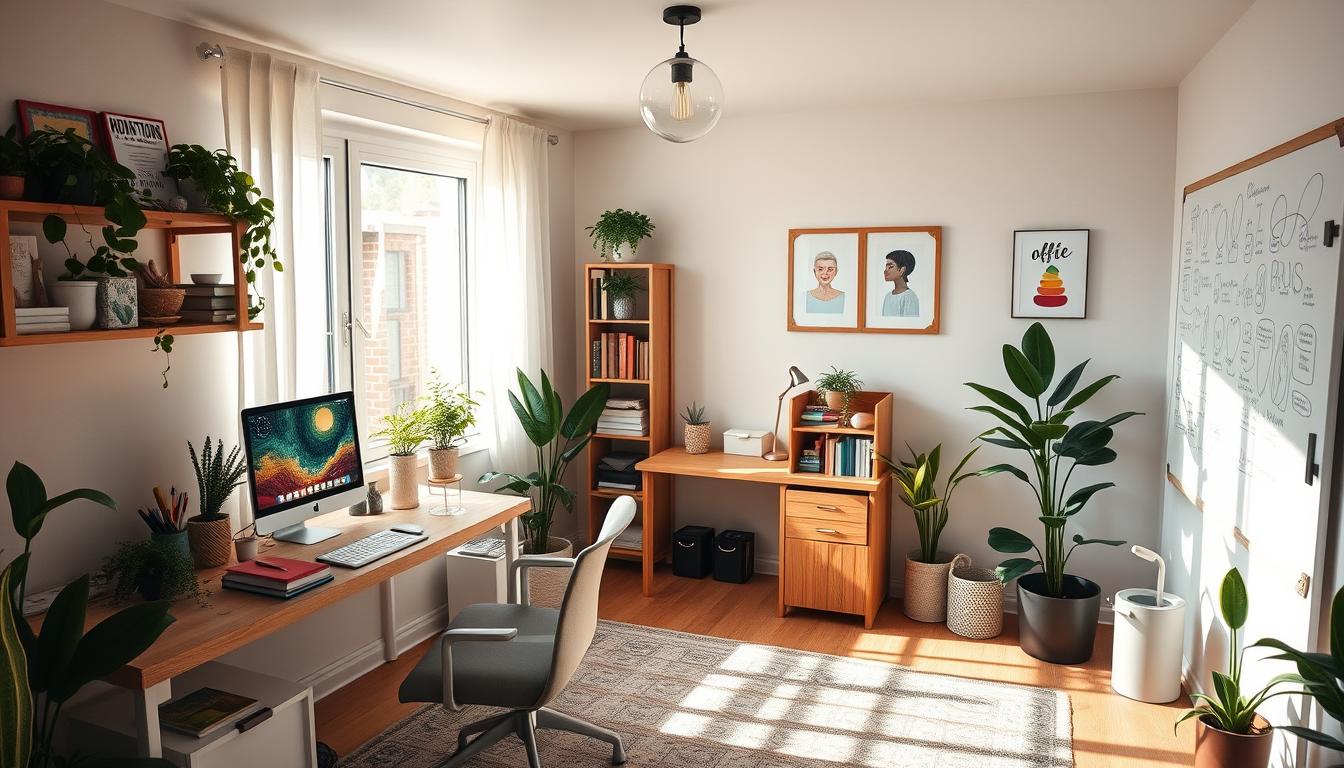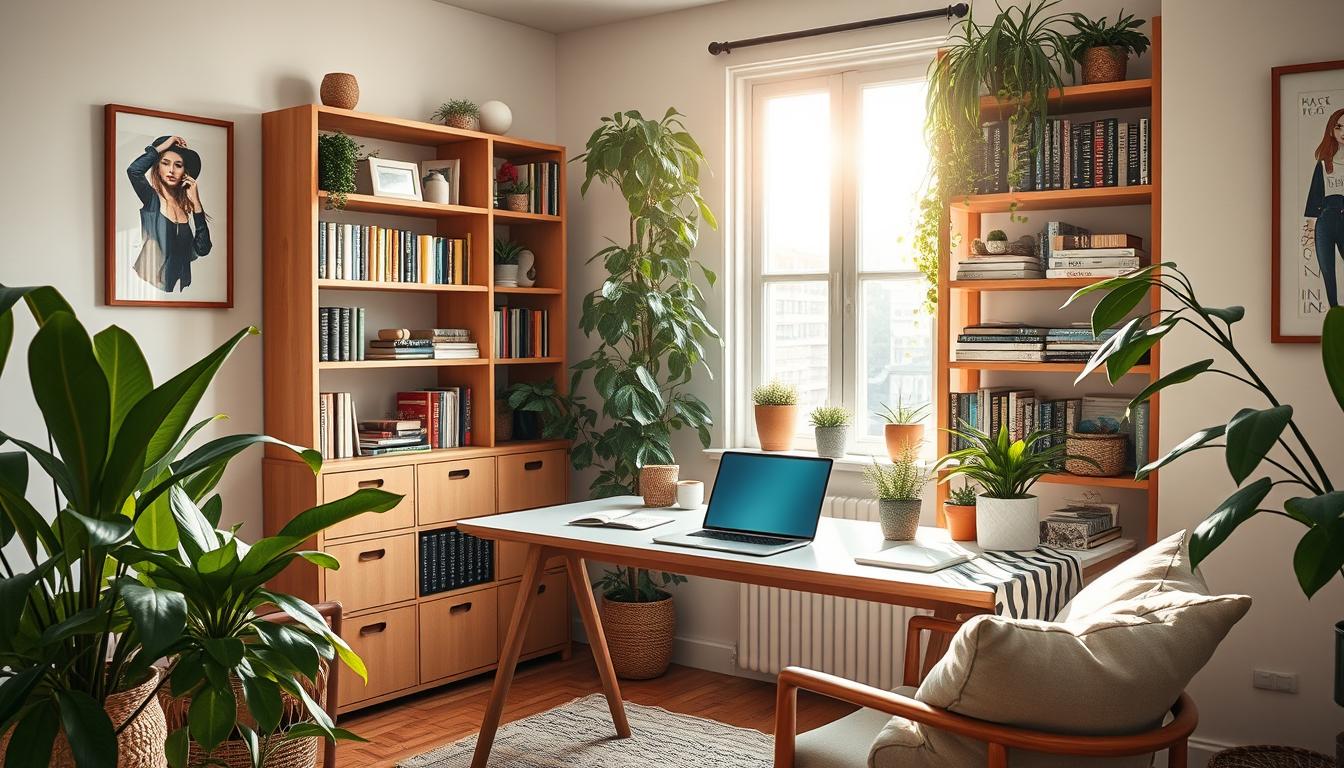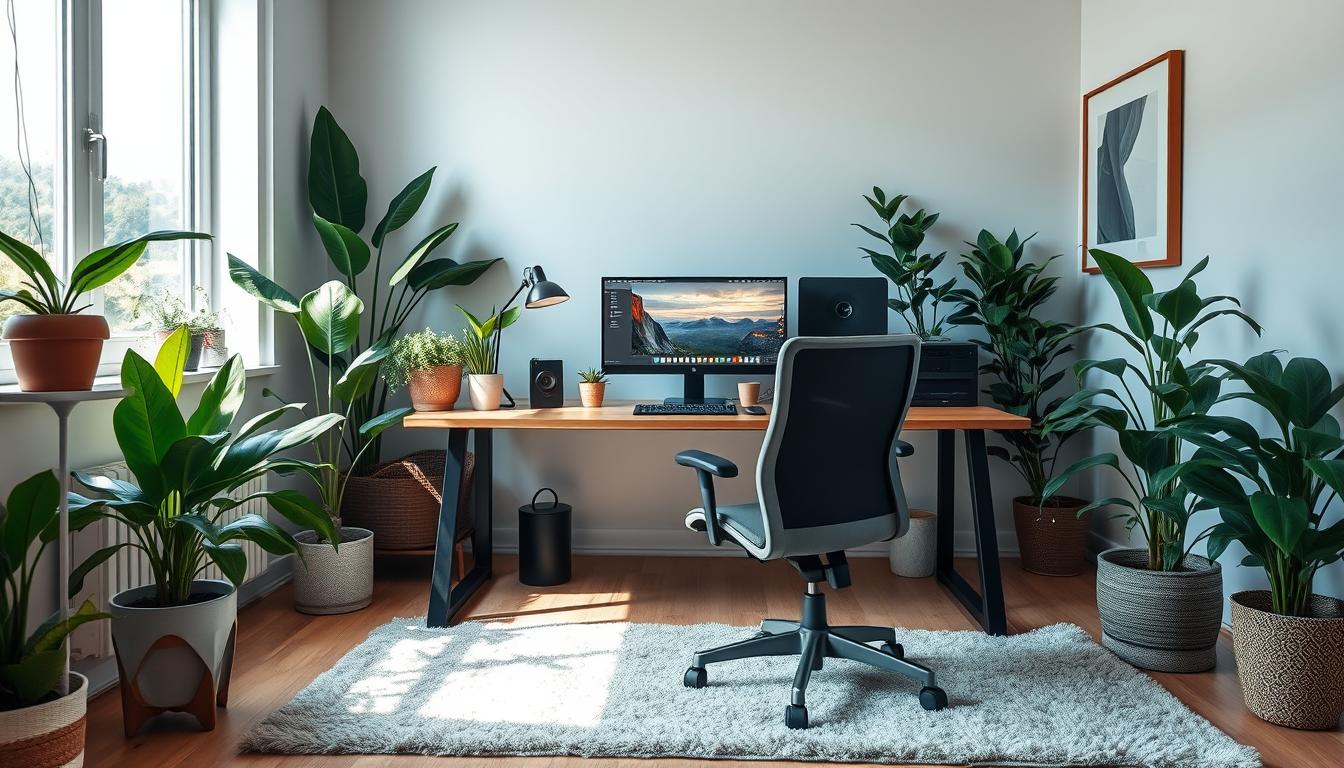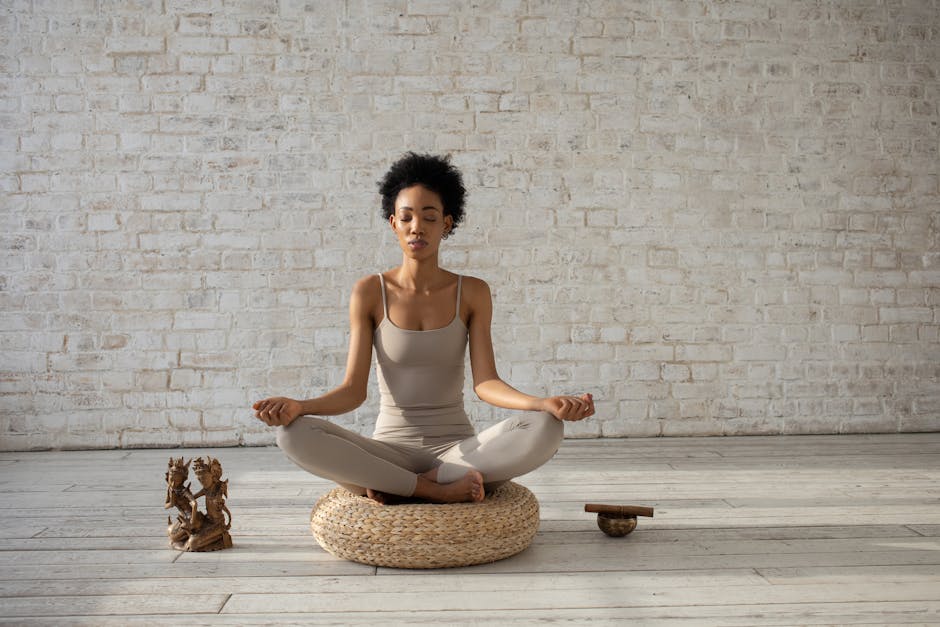Ever thought your home office design could boost both productivity and calm? With more people working from home, finding the ideal workspace is crucial. It’s not just about being productive; it’s also about feeling good while you work.
We’ll show you how to create a space that’s both efficient and relaxing. This means using ergonomic furniture, organizing well, and adding natural light. Plus, we’ll talk about how to make your office feel like a personal retreat.
Key Takeaways
- Optimize your home office design to boost productivity and well-being.
- Focus on workspace optimization with ergonomic furniture.
- Maximize natural light for a vibrant atmosphere.
- Maintain a stress-free work environment through efficient organization.
- Add personal touches to create a space that inspires and relaxes.
Choose the Perfect Location
Choosing the ideal home office location in your home can boost your productivity. A well-thought-out spot ensures a quiet work area. This helps avoid distractions and interruptions. So, pick a spot away from busy areas of your home.
An effective home office setup considers noise, privacy, and interruptions. Place your desk away from noisy streets and family areas. A room with a door helps create a quiet work area for better focus and work.
Think about space when planning your office. Choose a room that fits all your furniture and tools. A good home office setup is both functional and comfortable. It should have everything you need without feeling cramped.
In short, the ideal home office location meets your work and personal needs. Aim for a spot that’s both accessible and private. This setup helps you work effectively from home.
Maximize Natural Light
Ensuring your home office has enough natural light is crucial. The natural lighting benefits go beyond just seeing things clearly. They can also boost your mood and help you work better. Having your desk near a window can make your work area feel more lively and energized.
Good workspace lighting is key to avoiding eye strain. Natural light is soft and doesn’t cause glare, unlike artificial light. Using window treatments that filter light can make your space more comfortable and nice to look at.
Natural light also affects your mental health at work. It can make you feel happier and less tired. This is important for staying productive over time. So, always think about natural lighting benefits when setting up your home office. This way, you’ll have a bright, positive space that’s good for both work and your well-being.
Invest in Ergonomic Furniture
Setting up a productive home office starts with the right furniture. Choose pieces that help you sit right and avoid pain. Let’s look at the essential parts of an ergonomic setup for a better work space.
Ergonomic Chair
A good chair is key to any ergonomic setup. Find one with lumbar support and adjustable features for your needs. Comfortable seating keeps your back straight and prevents pain, helping you work better all day.
Adjustable Desk
An adjustable standing desk is crucial too. It lets you switch between sitting and standing, easing back and neck strain. A desk that moves with you keeps you comfy and healthy all day.
Proper Monitor Setup
Your monitor’s height is important for avoiding neck and shoulder pain. Make sure it’s at eye level. A well-placed monitor with your other ergonomic furniture makes a great workspace for success.
Organize Your Workspace Efficiently
Creating a tidy home office boosts your productivity. It reduces stress and keeps your space clutter-free. Good workspace organization makes your work area both useful and enjoyable.
Declutter Regularly
Decluttering often is a key decluttering tip. It stops clutter from growing. Begin by sorting through papers, supplies, and other items.
Get rid of what you don’t need. Keep only the important stuff. This not only saves space but also clears your mind.
Use Storage Solutions
Using office storage ideas keeps your area tidy. Shelves, cabinets, and drawers help organize items. Label boxes and containers for easy access.
Keep Essentials Accessible
Having what you need close by is crucial. Place your most used items, like pens and documents, within reach. Use desk trays, organizers, and wall holders for this.
Having office essentials nearby means less time searching. You can focus more on your work.
Here’s a quick guide to better workspace organization:
Task | Description | Benefit |
Declutter | Remove unnecessary items regularly | Clear space and reduce stress |
Storage Solutions | Use shelves, drawers, and containers | Efficient storage and easy access |
Keep Essentials Accessible | Place frequently used items nearby | Increased productivity |
Incorporate Calming Elements
A calm home office helps keep you relaxed all day. Adding calming decor to your space boosts your work and happiness.
Plants and Greenery
Plants are great for cleaning the air and making your office peaceful. Succulents, ferns, and peace lilies do more than just clean the air. They bring nature into your space, making it welcoming and calm.
Soothing Color Palette
Using color psychology in your office decor can change your mood and work. Soft colors like blues, greens, and beiges calm you down and help you focus. Use these colors for walls, furniture, and accessories to make a peaceful space.
Relaxing Scents
Aromatherapy in workspace is another smart way to lower stress and improve work. Essential oils like lavender, vanilla, and eucalyptus can be used to make a soothing smell. This smell helps ease tension and helps you concentrate better. Starting with these calming elements makes your workday stress-free and productive.
Implement Productive Zones
Changing your home office into productivity zones boosts your work efficiency. Imagine having task-specific areas for meetings, deep work, or brainstorming. These focused work zones help you stay on track and work better.
First, figure out what tasks you do every day. Then, set up task-specific areas in your office for each task. For example, a quiet spot for deep work and an open area for meetings. This way, you keep a steady work pace and stay productive.

Here’s a table to help you set up productive zones in your home office:
Zone Type | Recommended Setup | Benefits |
Focused Work Zones | Quiet, minimal distractions, ergonomic furniture | Enhanced concentration and deep thinking |
Meeting Areas | Good lighting, quality headset and webcam | More professional, effective communication |
Creative Spaces | Inspirational decor, whiteboard | Stimulates creativity and innovative thinking |
By organizing your office with task-specific areas and focused work zones, you create a better work space. A well-organized home office layout helps you reach your best.
Utilize Technology to Improve Workflow
Boosting your home office tech can make you more productive and efficient. The right tools and equipment help you manage tasks better, keep communication smooth, and stay connected without breaks.
Efficient Software Tools
Adding workflow software to your home office is key for managing tasks and working together. Asana, Trello, and Slack are great for organizing projects, tracking progress, and talking with your team live. They make complex workflows easy to follow, all in one spot.
High-Speed Internet
Having reliable internet connectivity is vital for a smooth workflow. Fast internet lets you quickly upload and download big files, join video conferencing calls without pause, and use cloud apps without delay. A strong internet plan means fewer disconnections and a smoother work flow.
Quality Headset and Webcam
For clear and professional talks, get the best video conferencing equipment. A good headset blocks out background noise, making your voice clear. A high-def webcam makes your video sharp and professional. Logitech and Sennheiser are top brands for these needs, helping you have effective virtual meetings.
Tool/Equipment | Function | Recommended Brands |
Workflow Software | Task Management and Collaboration | Asana, Trello, Slack |
High-Speed Internet | Seamless Connectivity | Verizon, AT&T, Comcast |
Video Conferencing Equipment | Clear Communication | Logitech, Sennheiser |
Personalize Your Space
Creating a unique and comfy workspace boosts your productivity. It lets you make your environment inspiring and motivating. This ensures everything shows off your personality. Whether you want to spark creativity or create a calm space, personalizing is key.
Inspiring Decorations
Adding inspiring decorations like motivational quotes and artwork can change your *workspace decor*. Art that speaks to you can fill your office with positivity and creativity. A vision board can help you stay focused on your goals every day.
Personal Touches
Personal touches make your office stand out and show off your style. Hang family photos, display travel souvenirs, or showcase handmade crafts. These add comfort and can spark interesting conversations during online meetings.
Comfortable Accessories
Comfort is crucial for staying productive. Choose *ergonomic accessories* like supportive cushions and wrist rests. A good mousepad, footrest, and monitor stand help you stay comfortable and avoid strain, making workdays better.
Create Boundaries Between Work and Home
Setting clear home office boundaries is key for a good work-life balance. Having a dedicated workspace in your home is a big help. It makes a clear line between work and personal time.
It’s also important to have set work hours. Start and end your workday at the same times every day. This helps you know when you’re working and when you’re not. It makes you more productive and helps your mental health.
Keeping distractions away is also crucial. Make rules for when you’re available and when you’re not. This makes it clear when you’re working and when you’re not.
Creating routines for the start and end of your workday is helpful too. For example, start with a morning coffee in your dedicated workspace. End with a walk outside. These routines help you know when you’re working and when you’re not.
Here’s a quick list of tips for setting work and home boundaries:
- Designate a dedicated workspace
- Set consistent work hours
- Manage distractions
- Develop routines to signal workday transitions
Maintain a Clean and Tidy Workspace
Keeping your workspace clean is key to being more productive. A tidy area helps you stay calm and focused. This makes you work better.
Good organization habits keep your office neat. Make it a habit to tidy up every day. This keeps your space clutter-free.
Going for a minimalist workspace cuts down on distractions. Having only what you need makes your work area clear and efficient. Here are some tips:
- Declutter: Get rid of things you don’t need.
- Storage Solutions: Use drawers, shelves, and containers to stay organized.
- Accessibility: Keep things you use often within easy reach.
A tidy office space is good for your mind too. Research shows a clean place lowers stress and boosts focus. Keeping your workspace clean helps you succeed every day.
Productive and Relaxing Home Office: The Ultimate Balance
Finding the right mix of work and rest is key for a great home office. A well-thought-out space can help you do your job better and feel good. This leads to more work done and less stress.
Balancing Work and Relaxation
Adding relaxation to your workday can make you more productive and clear-headed. A few deep breaths or a short meditation can keep you calm and sharp. These moments help you stay focused all day.
Flexible Work Schedule
Having a home office means you can work when you’re most productive. Adjusting your schedule to fit your best times can make you more efficient. This flexibility helps create a balanced work space.
Regular Breaks
Breaks are crucial for keeping your home office balanced. Short breaks can stop burnout and keep you excited about work. Use these times to move, drink water, or get some air. This way, you’ll come back to your tasks with energy and focus.
Benefits | Productivity Boost | Stress Reduction |
Relaxation Techniques | Enhances focus | Calms the mind |
Flexible Work Routine | Aligns with peak hours | Reduces time-related stress |
Regular Breaks | Prevents burnout | Offers mental refreshment |
Stay Motivated and Focused
Keeping motivation in a home office is key for staying productive and feeling good. We’ll share tips on staying driven and focused while working from home.
Set Clear Goals
Start by setting SMART goals: Specific, Measurable, Achievable, Relevant, and Time-bound. This method helps you have clear, doable goals to aim for.
Track Progress
Keep track of your progress regularly. This helps you stay on track and see how far you’ve gone. Use tools like Trello, Asana, or a simple spreadsheet to follow your progress.

Reward Yourself
Use a self-reward system to celebrate your wins. Break tasks into smaller parts and reward yourself when done. Enjoy a break, a favorite snack, or a walk. These rewards can really help your motivation in your home office.
Conclusion
Creating a productive and relaxing home office is key in today’s work-from-home world. Choose the right spot and make sure it gets plenty of natural light. This sets the stage for success.
Invest in ergonomic furniture like a good chair, adjustable desk, and the right monitor setup. It keeps you comfortable and healthy all day.
Keep your space organized with decluttering, storage, and easy access to what you need. Adding plants, calming colors, and scents makes your workspace peaceful. It balances work and relaxation well.
Use technology like efficient software and fast internet to make your work flow better. This keeps you connected and productive.
Make your office your own with inspiring decorations and comfy accessories. It boosts your motivation and focus. Set clear boundaries between work and home life to recharge well.
Keep your workspace clean and tidy. It helps you stay productive and relaxed. Follow these tips to improve your work life and overall happiness.
FAQ
What are the benefits of optimizing my home office design?
How do I choose the ideal location for my home office?
Why is maximizing natural light important in a home office?
What should I look for in ergonomic office furniture?
How can I organize my workspace efficiently?
What calming elements can I incorporate into my home office?
How do productive zones enhance my home office layout?
What technology should I use to improve my workflow?
How can I personalize my home office effectively?
What strategies can I use to create boundaries between work and home?
How do I maintain a clean and tidy workspace?
How can I balance productivity with relaxation in my home office?
How do I stay motivated and focused in my home office?



